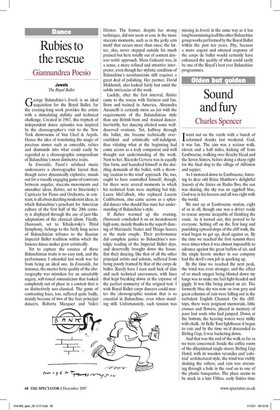Rubies to the rescue
Giannandrea Poesio Jewels The Royal Ballet George Balanchine's Jewels is an ideal acquisition for the Royal Ballet, for the evening-long work provides the artists with a stimulating stylistic and technical challenge. Created in 1967, this triptych of independent dance episodes was inspired by the choreographer's visit to the New York showrooms of Van Cleef & Arpels. Hence the idea of translating the magic of precious stones such as emeralds, rubies and diamonds into what could easily be regarded as a choreographic compendium of Balanchine's most distinctive traits.
In Emeralds, Faure's subdued music underscores a choreographic layout that, though never dynamically explosive, stands out for a visually engaging game of contrasts between angular, staccato movements and smoother ideas. Rubies, set to Stravinsky's Capriccio for Piano and Orchestra, in contrast, is all about dazzling modernist ideas, in which Balanchine's penchant for American culture of the first half of the 20th century is displayed through the use of jazz-like adaptations of the classical idiom. Finally, Diamonds, set to Tchaikovsky's Third Symphony, belongs to the fairly long series of Balanchinian tributes to the Russian Imperial Ballet tradition within which the famous dance-maker grew artistically.
Yet to capture the essence of these Balanchinian traits is no easy task, and the performance I attended last week was far from being an ideal one. In Emeralds, for instance, the mezzo-forte quality of the choreography was mistaken for an unsuitably sugary, soft-toned romanticism that looked completely out of place in a context that is so distinctively neo-classical. The game of contrasting hues, too, suffered quite badly, mainly because of two of the four principal dancers, Roberta Marquez and Valeri Hristov. The former, despite her strong technique, did not seem at ease in the more staccato moments, such as in the jerky arm motif that occurs more than once; the latter, alas, never stepped outside his much praised but here totally out of context danseur noble approach. Mara Galeazzi was, in a sense, a more refined and attentive interpreter, even though her stylistic rendition of Balanchine's neoclassicism still requires a great deal of polishing. Her partner, David Makhateli, also looked fairly lost amid the subtle intricacies of the work.
Luckily, after the first interval, Rubies came to the rescue with fizziness and fun. Born and trained in America, Alexandra Ansanelli is certainly more au fait with the requirements of the Balanchinian style than any British-born and -trained dancer. Inevitably, her dancing elicited some welldeserved ovations. Yet, halfway through the ballet, she became technically overconfident and artistically self-indulgent, thus vitiating what at the beginning had come across as a truly competent and well thought out understanding of the work. Next to her, Ricardo Cervera was in equally fine form, and launched himself at the dazzling demands of the ballet, with a throwing 'caution to the wind' approach. He, too, ought to have controlled himself, though, for there were several moments in which his technical feats were anything but tidy. Laura McCulloch, who replaced Lauren Cuthbertson, also came across as a splendid dancer who should fine-tune her understanding of Balanchine's style.
If Rubies warmed up the evening, Diamonds concluded it on an incandescent high note, mainly thanks to the superb dancing of Marianela Nunez and Thiago Soares as the main couple. Their performance did complete justice to Balanchine's nostalgic reading of the Imperial Ballet days, and deservedly brought down the house. But their dancing, like that of all the other principal artists and soloists, suffered from being poorly framed by that of the corps de ballet. Rarely have I seen such lack of élan and such technical unevenness, with lines that kept breaking down at the expense of the perfect symmetry of the original text. I wish Royal Ballet corps dancers could master the choreographic tension that is so essential in Balanchine, even when standing still. Unfortunately, such tension was missing in Jewels in the same way as it has longbeen missing in all the other Balanchine group works performed by the Royal Ballet within the past ten years. Pity, because a more cogent and attuned response of the corps de ballet would certainly have enhanced the quality of what could easily be one of the Royal's best ever Balanchine programmes.

























































 Previous page
Previous page